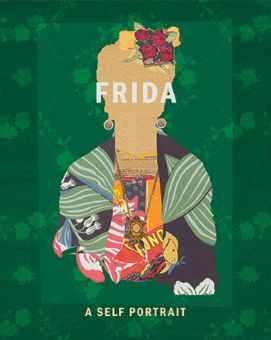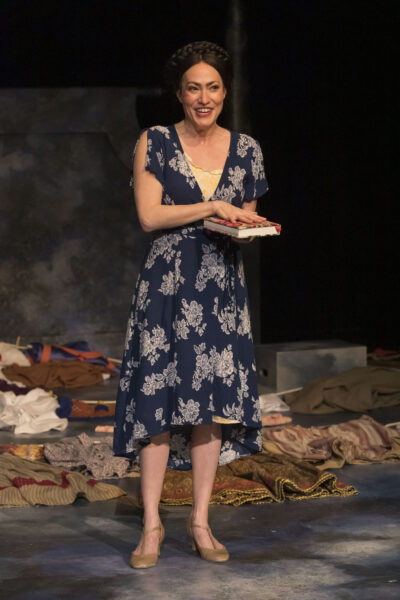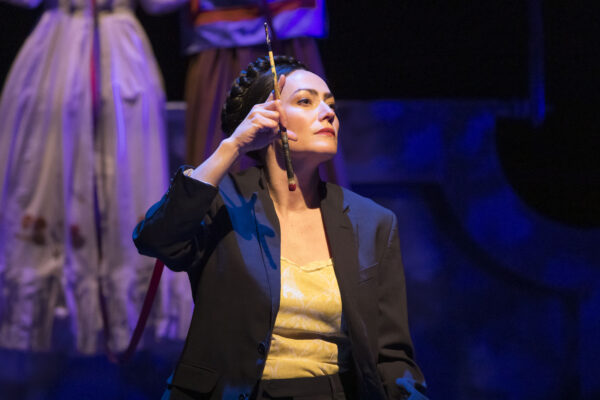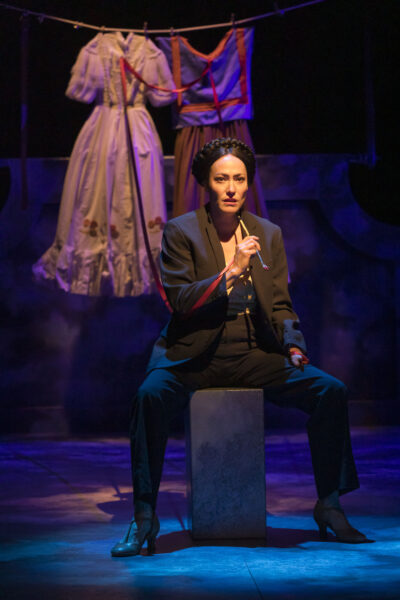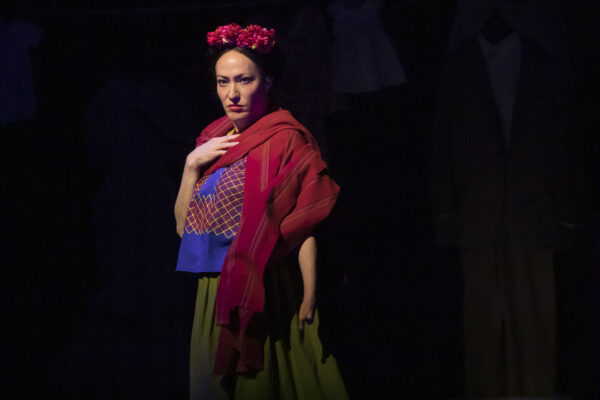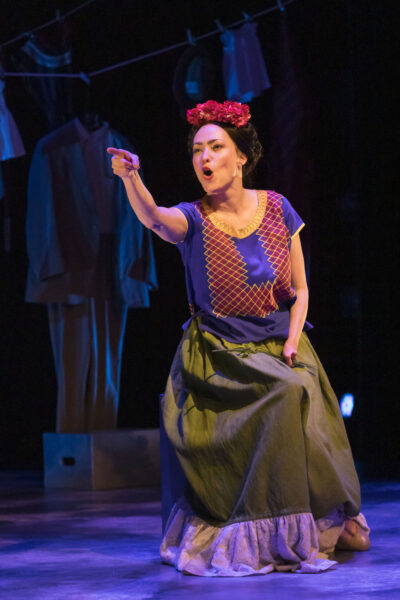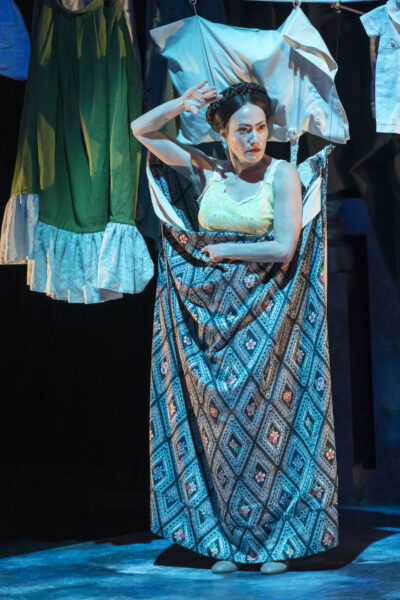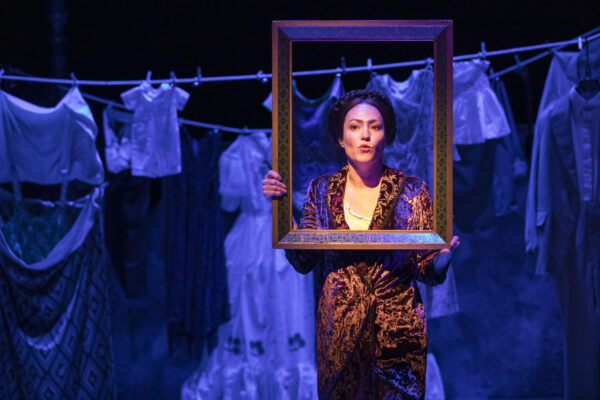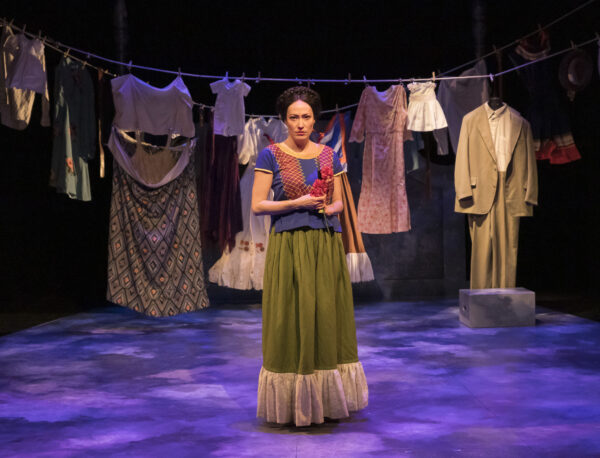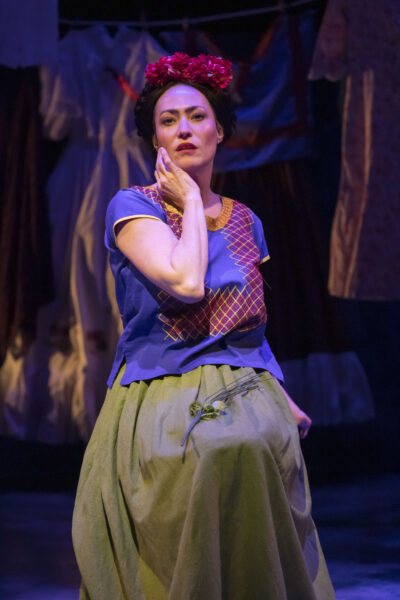Frida…A Self Portrait
Enlightens and Beguiles with Impressive Force
You’d have to go a long way to find someone with as potent a life force as Frida Kahlo’s. She left this branch of existence just over 70 years ago, in 1954, and still, there’s something about her spirit that continues to enthrall the imagination of her fans and admirers of her idiosyncratic art. Writer and performer Vanessa Severo is one of those fans who developed a special affinity for Kahlo. Her fascination with this cultural icon, along with a comment from a friend stating that Severo reminded her of Kahlo, sparked a flame in the Brazilian born creative. From this, Frida…A Self Portrait was born.
A one-woman play written and performed by Severo, it first appeared in 2013. Now, twelve year later and extended to 75 minutes in length, its newer more refined version is playing at Writers Theatre in Glencoe. A captivating effort, it weaves in elements of Severo’s own life to add emphasis and enhance the story of Kahlo’s. Directed by Joanie Schultz, it’s also extremely dynamic and fast paced. The momentum it builds gives the production a surprisingly suspenseful tone.
Filled with physical movement, some strenuous, as well as rapid transitions between life episodes, much of that energy comes from Severo herself as she embodies a wide swath of characters. Down to earth and thoroughly engaging when she’s addressing the audience as herself, and completely immersed and credible in the role when she’s portraying Kahlo, her performance throughout is impeccable.
Kahlo was an acclaimed Mexican artist with a grim health backstory, and most people are only vaguely aware of the amount of physical suffering Kahlo endured through much of her life. The otherness that physical limitations create is something Severo knows, too. Kahlo contracted polio when she was very young and at 18 was horrifically injured in trolley accident. “Her spinal column was broken, her left leg smashed, and her right foot was crushed. An iron handrail pieced her pelvis.” The ramifications of that accident, requiring more than 30 subsequent surgeries, would go on to shape the rest of her life and be a key element in much of her art.
Although not nearly as traumatic or impacting, Severo was born with a condition that prevented one of her hands from fully forming. She knows what it’s like to be subjected to questionable medical scrutiny and care, instilling in her an abiding empathy for Kahlo. It’s the depth and vitality of that empathy that give Frida…A Self Portrait it’s heart. Thomas Dixon’s sound design and original music not only bring an element of extraordinary beauty to the production, they also add refined emphasis to Severo’s performance.
Although she always displayed artistic leanings, the accident and cascade of surgeries are said to be the chief impetus for Kahlo turning to painting. They’re also the reasons why her primary subject was herself. Severo treats segments in the show dwelling on her hospitalizations with deferential tenderness and acute intelligence. As she’s playing Frida, you feel the unremittingness of her plight and grasp a tiny but meaningful understanding of her pain.
Some scenes prove slightly confusing or unclear. When Severo portrays Kahlo lying in bed, reviewing and discussing the hardships of her life and her will to overcome them, she frequently reenacts the artist injecting herself with a substance. These are sensitive, almost troubling depictions. When Kahlo died at 47 from a pulmonary embolism caused by pneumonia, it was rumored that she had actually overdosed from pain killers. The subject of her drug use or the truth of speculations surrounding it is never directly addressed. Given the severity of her condition and the number of spinal and other surgeries she endured, it would seem reasonable to presume that at least some of the treatments she administered to herself were medically sanctioned. But that cloud of uncertainty is a part of the mystery of Kahlo, and more insight regarding it would help us view the issue from a more knowledgeable perspective.
Bringing to life Kahlo’s ferocity of spirit, though, counts as an overriding highlight of this very fine tribute. Through it you gain an understanding of how the artist acquired the determination she used to armor herself. The way Severo climbs into Kahlo’s skin, you can feel how her German born father’s stoic iron-etched grit gets transferred to his physically challenged daughter and how she transforms it into something uniquely her own.
Along with the restrictions on her physical reality, Kahlo soon found her gender to be another impediment as she strove to make headway in the art world. Approaching her would-be husband, Diego Rivera, to act as a teacher or mentor, she insists that her work be viewed and judged purely on merit, without regard to its creator’s sex. Once she becomes his wife, she and her work are nonetheless relegated to a shadow position, a position to which she knew she did not belong. As tumultuous as their marriage and relationship were, Diego clearly knew she didn’t belong there either. When talking about his wife’s work to Picasso, he’s been quoted as describing it as “acid and tender, hard as steel and delicate and fine as a butterfly’s wing, lovable as a beautiful smile, and profound and cruel as the bitterness of life.”
Each of those attributes of the artist’s life and work shine in Frida…A Self Portrait, too; making it powerful, engaging and perhaps most importantly, rewardingly memorable.
photos by Zach Rosing, courtesy of Indiana Repertory Theatre
Frida…A Self Portrait
Writers Theatre
Nichols Theatre, 325 Tudor Court in Glencoe
Wed at 3 (Feb. 5 & 19); Wed-Fri at 7:30; Sat at 3 & 7:30; Sun at 2
ends on February 23, 2025
for tickets, call 847.242.6000 or visit Writers Theatre
for more shows, visit Theatre in Chicago
